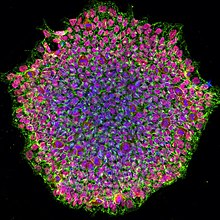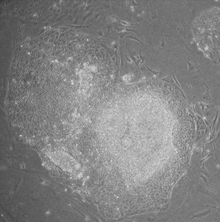
Back خلية جذعية كثيرة القدرة مستحثة Arabic Cèl·lules IPS Catalan Indukovaná pluripotentní kmenová buňka Czech Induzierte pluripotente Stammzelle German Célula madre pluripotente inducida Spanish Indusoitu pluripotentti kantasolu Finnish Cellule souche pluripotente induite French Célula nai pluripotente inducida Galician Sel iPS ID Cellula staminale pluripotente indotta Italian
This article may rely excessively on sources too closely associated with the subject, potentially preventing the article from being verifiable and neutral. (October 2016) |


Induced pluripotent stem cells (also known as iPS cells or iPSCs) are a type of pluripotent stem cell that can be generated directly from a somatic cell. The iPSC technology was pioneered by Shinya Yamanaka and Kazutoshi Takahashi in Kyoto, Japan, who together showed in 2006 that the introduction of four specific genes (named Myc, Oct3/4, Sox2 and Klf4), collectively known as Yamanaka factors, encoding transcription factors could convert somatic cells into pluripotent stem cells.[1] Shinya Yamanaka was awarded the 2012 Nobel Prize along with Sir John Gurdon "for the discovery that mature cells can be reprogrammed to become pluripotent."[2]
Pluripotent stem cells hold promise in the field of regenerative medicine.[3] Because they can propagate indefinitely, as well as give rise to every other cell type in the body (such as neurons, heart, pancreatic, and liver cells), they represent a single source of cells that could be used to replace those lost to damage or disease.
The most well-known type of pluripotent stem cell is the embryonic stem cell. However, since the generation of embryonic stem cells involves destruction (or at least manipulation)[4] of the pre-implantation stage embryo, there has been much controversy surrounding their use. Patient-matched embryonic stem cell lines can now be derived using somatic cell nuclear transfer (SCNT).[citation needed]
Since iPSCs can be derived directly from adult tissues, they not only bypass the need for embryos, but can be made in a patient-matched manner, which means that each individual could have their own pluripotent stem cell line. These unlimited supplies of autologous cells could be used to generate transplants without the risk of immune rejection. While the iPSC technology has not yet advanced to a stage where therapeutic transplants have been deemed safe, iPSCs are readily being used in personalized drug discovery efforts and understanding the patient-specific basis of disease.[5]
Yamanaka named iPSCs with a lower case "i" due to the popularity of the iPod and other products.[6][7][8][9][10][dubious ]
In his Nobel seminar, Yamanaka cited the earlier seminal work of Harold Weintraub on the role of myoblast determination protein 1 (MyoD) in reprogramming cell fate to a muscle lineage as an important precursor to the discovery of iPSCs.[11]
- ^ Takahashi K, Yamanaka S (August 2006). "Induction of pluripotent stem cells from mouse embryonic and adult fibroblast cultures by defined factors". Cell. 126 (4): 663–76. doi:10.1016/j.cell.2006.07.024. hdl:2433/159777. PMID 16904174.

- ^ "The Nobel Prize in Physiology or Medicine – 2012 Press Release". Nobel Media AB. 8 October 2012.
- ^ Mahla RS (2016). "Stem Cells Applications in Regenerative Medicine and Disease Therapeutics". International Journal of Cell Biology. 2016: 6940283. doi:10.1155/2016/6940283. PMC 4969512. PMID 27516776.
- ^ Klimanskaya I, Chung Y, Becker S, Lu SJ, Lanza R (November 2006). "Human embryonic stem cell lines derived from single blastomeres". Nature. 444 (7118): 481–5. Bibcode:2006Natur.444..481K. doi:10.1038/nature05142. PMID 16929302. S2CID 84792371.
- ^ Hockemeyer D, Jaenisch R (May 2016). "Induced Pluripotent Stem Cells Meet Genome Editing". Cell Stem Cell. 18 (5): 573–86. doi:10.1016/j.stem.2016.04.013. PMC 4871596. PMID 27152442.
- ^ Yamanaka 2010, p. 120.
- ^ "「i」PSなぜ小文字? 山中さんってどんな人?". 朝日新聞. 8 October 2012. Archived from the original on 21 November 2012. Retrieved 27 April 2013.
- ^ "万能なiPS細胞「iPodのように普及してほしい」". スポーツニッポン. 9 October 2012. Retrieved 14 October 2012.
- ^ "山中教授の「iPS細胞」ってiPod のパクリ!?流行らせたいと頭小文字". J-CASTニュース. 9 October 2012. Retrieved 28 April 2013.
- ^ Eguizabal C, Aran B, Chuva de Sousa Lopes SM, Geens M, Heindryckx B, Panula S, Popovic M, Vassena R, Veiga A (2019). "Two decades of embryonic stem cells: a historical overview". Human Reproduction Open. 2019 (1): hoy024. doi:10.1093/hropen/hoy024. PMC 6396646. PMID 30895264.
- ^ Yamanaka S (December 2013). "The winding road to pluripotency (Nobel Lecture)". Angewandte Chemie. 52 (52): 13900–9. doi:10.1002/anie.201306721. PMID 24255017.
© MMXXIII Rich X Search. We shall prevail. All rights reserved. Rich X Search